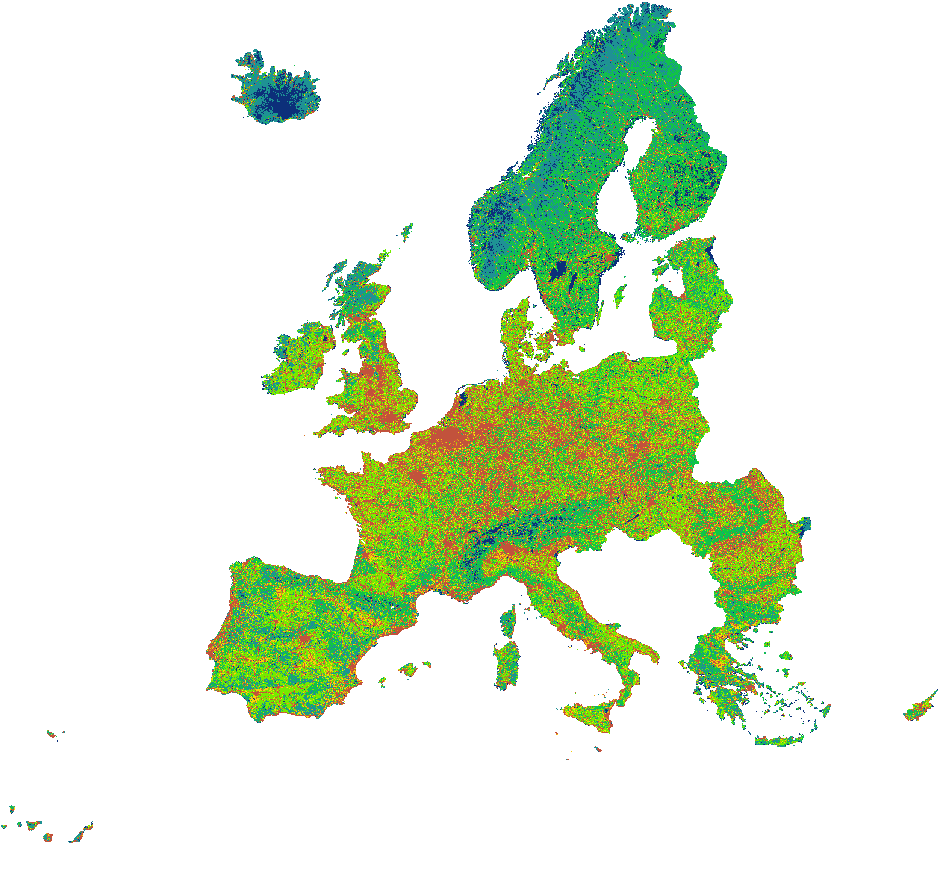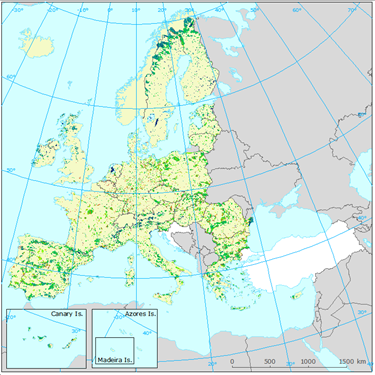EEA33 (2013-2020)
Type of resources
Available actions
Topics
INSPIRE themes
Keywords
Contact for the resource
Provided by
Years
Formats
Representation types
Update frequencies
status
Scale
Resolution
-

Within the European Union, the Environmental Noise Directive (END, 2002/49/EC) defines quiet areas outside cities as those areas delimited by national authorities that are undisturbed by noise from traffic, industry or recreational activities. The report ‘Quiet areas in Europe: the environment unaffected by noise pollution,’ provides a first mapping assessment of potential quiet areas in Europe’s rural regions. Approximately 18% of Europe’s area can be considered quiet, but 33% is potentially affected by noise pollution, the report finds. This dataset underpins the assessment and is based on the quietness suitability index (QSI), which provides the overview with the highest (QSI=1) and lowest (QSI=0) proportion of potential quiet areas in Europe. The data set is provided in both GDB and TIFF formats.
-

UWWTD Discharge Points, Oct. 2019 is one of the datasets produced within the frame of the reporting under 10th UWWTD Art.15 reporting period (UWWTD data call 2017). The Urban Waste Water Treatment Directive (UWWTD) (91/271/EEC) obliges Member States to report data on the implementation of the Directive upon request from the European Commission bi-annually. Reported data include receiving areas as designated under UWWTD, agglomerations, urban waste water treatment plants serving the agglomerations and points of discharges. Dataset UWWTD_DischargePoints contains information on individual points of discharge from urban waste water treatment plants or collecting systems, including their coordinates of discharge, link to specific treatment plant, type of receiving area into which the effluent / wastewater is discharged, related waterbody (or river basin), information on the discharge on land and potential reuse of the treated waste water. The public dataset of discharge points is not used in published UWWTD maps (https://www.eea.europa.eu/themes/water/european-waters/water-use-and-environmental-pressures/uwwtd/interactive-maps/urban-waste-water-treatment-maps-2) for the time being. The source discharge points dataset is available in tabular format through the EEA website (https://www.eea.europa.eu/data-and-maps/data/waterbase-uwwtd-urban-waste-water-treatment-directive-6). The full (internal) dataset including inactive discharge points is available under "Urban Waste Water Treatment Directive, Discharge points reported under UWWTD data call 2017 - INTERNAL VERSION - Oct. 2019"
-

UWWTD Agglomerations, Oct. 2019 is one of the datasets produced within the frame of the reporting under 10th UWWTD Art.15 reporting period (UWWTD data call 2017). The Urban Waste Water Treatment Directive (UWWTD) (91/271/EEC) obliges Member States to report data on the implementation of the Directive upon request from the European Commission bi-annually. Reported data include receiving areas as designated under UWWTD, agglomerations, urban waste water treatment plants serving the agglomerations and points of discharges. Dataset UWWTD_Agglomerations contains agglomerations reported by countries with generated load ≥ 2000 p.e. (or even smaller), including names, coordinates, generated load and information whether the load generated is collected through collecting system or addressed via Individual Appropriate Systems (IAS) or not collected not addressed via IAS. This internal dataset contains all reported agglomerations, including inactive ones. Agglomerations with obviously wrong coordinates were excluded only. The public dataset excluding inactive agglomerations can be found under the entry "Urban Waste Water Treatment Directive, Agglomerations - PUBLIC VERSION - Oct. 2019".
-

Within the European Union, the Environmental Noise Directive (END; 2002/49/EC) defines quiet areas outside cities as those areas delimited by national authorities that are undisturbed by noise from traffic, industry or recreational activities. In this dataset, two datasets has been brought together to visualize how human made noise have an impact on nature protected areas: the Natura2000 dataset and the quietness suitable index dataset. The data set is provided by countries both in Geodatabase and Geopackage formats.
-

The Common Database on Designated Areas (CDDA) is more commonly known as Nationally designated areas. The inventory began in 1995 under the CORINE programme of the European Commission. It is now one of the agreed Eionet priority data flows maintained by EEA with support from the European Topic Centre on Biological Diversity. It is a result of an annual data flow through Eionet countries. The EEA publishes the data set and makes it available to the World Database of Protected Areas (WDPA). The CDDA data can also be queried online in the European Nature Information System (EUNIS). Geographical coverage of GIS vector boundary data: Albania, Austria, Belgium, Bosnia and Herzegovina, Bulgaria, Croatia, Cyprus, Czech Republic, Denmark, Estonia, Finland, Great Britain, Greece, Ireland, France, Germany, Iceland, Italy, Kosovo under UNSC Resolution 1244/99, Latvia, Liechtenstein, Lithuania, the North Macedonia, the Netherlands, Norway, Poland, Portugal, Romania, Serbia, Slovakia, Slovenia, Spain, Sweden and Switzerland. EEA does not have permission to distribute some or all sites reported by Austria, Bulgaria, Estonia, Ireland, Romania and Turkey. When re-using the data, copyright is to be mentioned specifically for Estonia and for Finland: "Estonian Environmental Register 02.03.2015"; "©Finnish Environment Institute, 2015".
-

The Common Database on Designated Areas (CDDA) is more commonly known as Nationally designated areas. The inventory began in 1995 under the CORINE programme of the European Commission. It is now one of the agreed Eionet priority data flows maintained by EEA with support from the European Topic Centre on Biological Diversity. It is a result of an annual data flow through Eionet countries. The EEA publishes the data set and makes it available to the World Database of Protected Areas (WDPA). The CDDA data can also be queried online in the European Nature Information System (EUNIS). Geographical coverage of GIS vector boundary data: Albania, Austria, Belgium, Bosnia and Herzegovina, Bulgaria, Croatia, Cyprus, Czech Republic, Denmark, Estonia, Finland, Great Britain, Greece, Ireland, France, Germany, Iceland, Italy, Kosovo under UNSC Resolution 1244/99, Latvia, Liechtenstein, Lithuania, the North Macedonia, the Netherlands, Norway, Poland, Portugal, Romania, Serbia, Slovakia, Slovenia, Spain, Sweden and Switzerland. EEA does not have permission to distribute some or all sites reported by Estonia, Romania and Turkey. Copyright is to be mentioned for Estonia and Finland when re-use of the dataset includes these countries. For Estonia: "Estonian Environmental Register 25.02.2014”. For Finland: "©Finnish Environment Institute, 2014".
-

The Common Database on Designated Areas (CDDA) is more commonly known as Nationally designated areas. The inventory began in 1995 under the CORINE programme of the European Commission. It is now one of the agreed Eionet priority data flows maintained by EEA with support from the European Topic Centre on Biological Diversity. It is a result of an annual data flow through Eionet countries. The EEA publishes the data set and makes it available to the World Database of Protected Areas (WDPA). The CDDA data can also be queried online in the European Nature Information System (EUNIS). Geographical coverage of GIS vector boundary data: Albania, Austria, Belgium, Bosnia and Herzegovina, Bulgaria, Croatia, Cyprus, Czech Republic, Denmark, Estonia, Finland, Great Britain, Greece, Ireland, France, Germany, Iceland, Italy, Kosovo under UNSC Resolution 1244/99, Latvia, Liechtenstein, Lithuania, the North Macedonia, the Netherlands, Norway, Poland, Portugal, Romania, Serbia, Slovakia, Slovenia, Spain, Sweden and Switzerland. EEA does not have permission to distribute some or all sites reported by Austria, Estonia, Hungary, Ireland, Kosovo under UNSC Resolution 1244/99, Malta, the Netherlands, Romania, Slovenia and Turkey. Copyright is to be mentioned for Estonia: "Estonian Environmental Register 18.02.2013. On-line resource linkage: www.keskkonnainfo.ee"; and for Finland: "©Finnish Environment Institute, 2012".
-

The Common Database on Designated Areas (CDDA) is more commonly known as Nationally designated areas. The inventory began in 1995 under the CORINE programme of the European Commission. It is now one of the agreed Eionet priority data flows maintained by EEA with support from the European Topic Centre on Biological Diversity. It is a result of an annual data flow through Eionet countries. The EEA publishes the data set and makes it available to the World Database of Protected Areas (WDPA). The CDDA data can also be queried online in the European Nature Information System (EUNIS). Geographical coverage of GIS vector boundary data: Albania, Austria, Belgium, Bosnia and Herzegovina, Bulgaria, Croatia, Cyprus, Czech Republic, Denmark, Estonia, Finland, Great Britain, Greece, Ireland, France, Germany, Iceland, Italy, Kosovo under UNSC Resolution 1244/99, Latvia, Liechtenstein, Lithuania, the North Macedonia, the Netherlands, Norway, Poland, Portugal, Romania, Serbia, Slovakia, Slovenia, Spain, Sweden and Switzerland. EEA does not have permission to distribute some or all sites reported by Austria, Bulgaria, Estonia, Ireland, Romania and Turkey. When re-using the data, copyright is to be mentioned specifically for Estonia and for Finland: "Estonian Environmental Register 02.03.2015"; "©Finnish Environment Institute, 2015".
-

The Common Database on Designated Areas (CDDA) is more commonly known as Nationally designated areas. The inventory began in 1995 under the CORINE programme of the European Commission. It is now one of the agreed Eionet priority data flows maintained by EEA with support from the European Topic Centre on Biological Diversity. It is a result of an annual data flow through Eionet countries. The EEA publishes the data set and makes it available to the World Database of Protected Areas (WDPA). The CDDA data can also be queried online in the European Nature Information System (EUNIS). Geographical coverage of GIS vector boundary data: Albania, Austria, Belgium, Bosnia and Herzegovina, Bulgaria, Croatia, Cyprus, Czech Republic, Denmark, Estonia, Finland, Great Britain, Greece, Ireland, France, Germany, Iceland, Italy, Kosovo under UNSC Resolution 1244/99, Latvia, Liechtenstein, Lithuania, the North Macedonia, the Netherlands, Norway, Poland, Portugal, Romania, Serbia, Slovakia, Slovenia, Spain, Sweden and Switzerland. EEA does not have permission to distribute some or all sites reported by Estonia, Romania and Turkey. Copyright is to be mentioned for Estonia and Finland when re-use of the dataset includes these countries. For Estonia: "Estonian Environmental Register 25.02.2014”. For Finland: "©Finnish Environment Institute, 2014".
-

UWWTD Agglomerations, Oct. 2019 is one of the datasets produced within the frame of the reporting under 10th UWWTD Art.15 reporting period (UWWTD data call 2017). The Urban Waste Water Treatment Directive (UWWTD) (91/271/EEC) obliges Member States to report data on the implementation of the Directive upon request from the European Commission bi-annually. Reported data include receiving areas as designated under UWWTD, agglomerations, urban waste water treatment plants serving the agglomerations and points of discharges. Dataset UWWTD_Agglomerations contains agglomerations reported by countries with generated load ≥ 2000 p.e. (or even smaller), including names, coordinates, generated load and information whether the load generated is collected through collecting system or addressed via Individual Appropriate Systems (IAS) or not collected not addressed via IAS. This dataset includes the reported agglomerations which are displayed on the UWWTD maps (https://www.eea.europa.eu/themes/water/european-waters/water-use-and-environmental-pressures/uwwtd/interactive-maps/urban-waste-water-treatment-maps-2). The active agglomerations with correct coordinates in the reported data were selected from the source European UWWTD tabular dataset, which is available on the download link https://www.eea.europa.eu/data-and-maps/data/waterbase-uwwtd-urban-waste-water-treatment-directive-6. The internal dataset which includes the inactive agglomerations as well is available under "Urban Waste Water Treatment Directive, Agglomerations reported under UWWTD data call 2017- INTERNAL VERSION - Oct. 2019".
 RUC Geo-Data catalogue
RUC Geo-Data catalogue